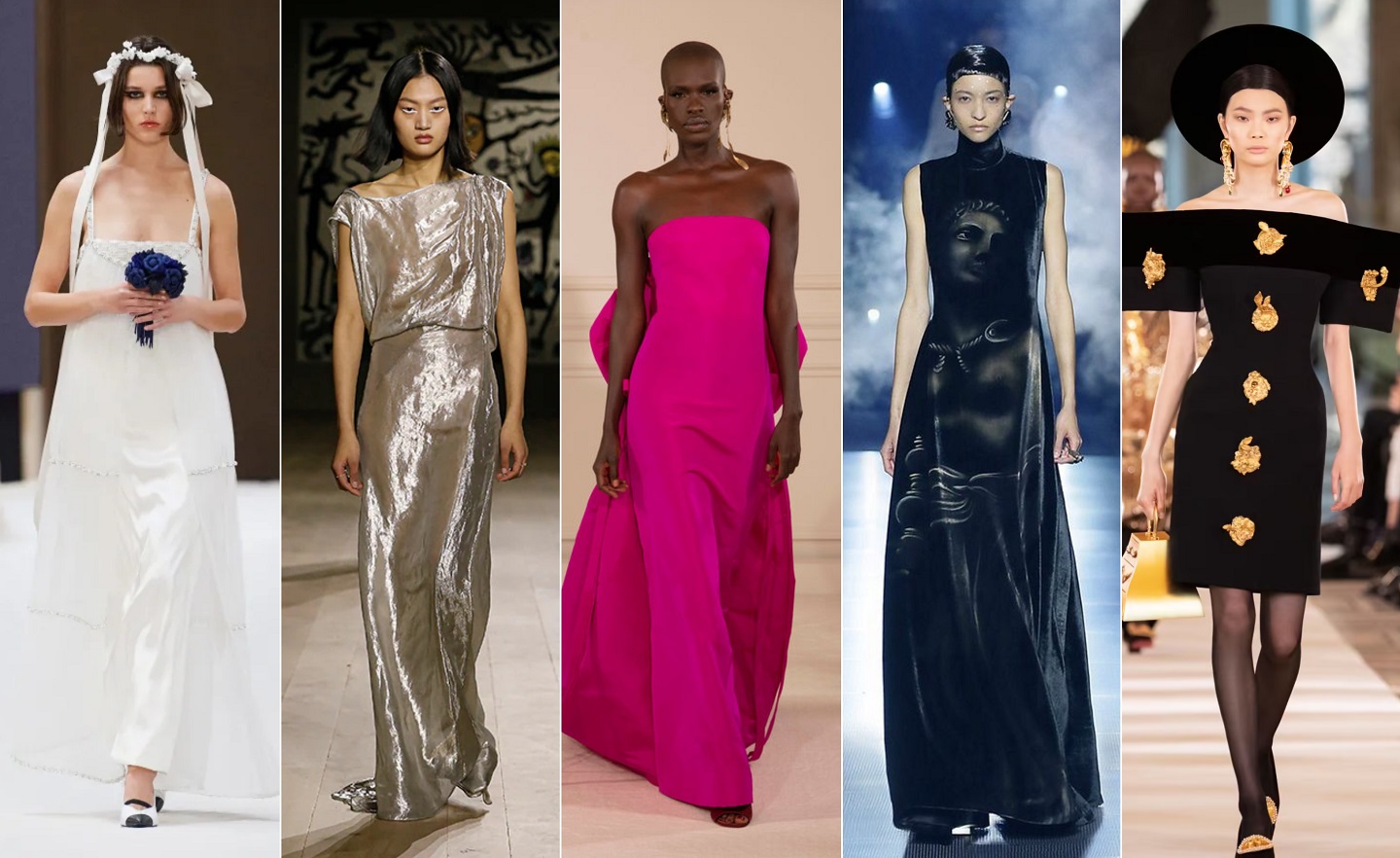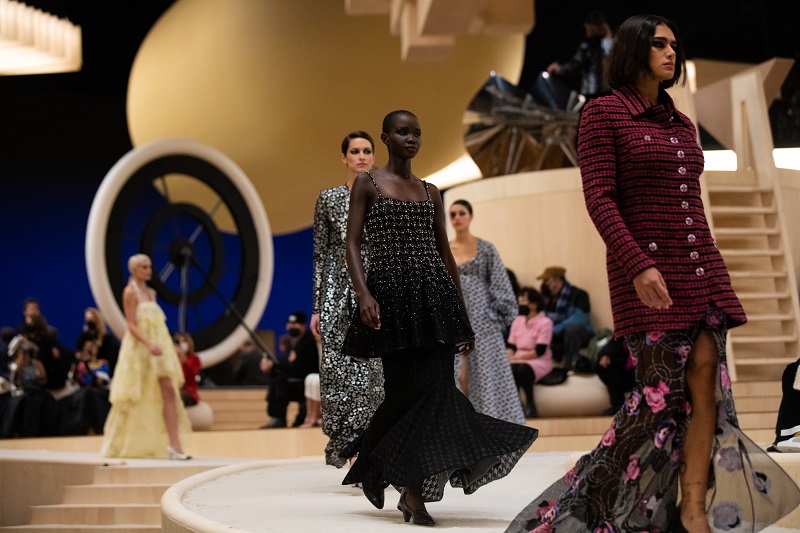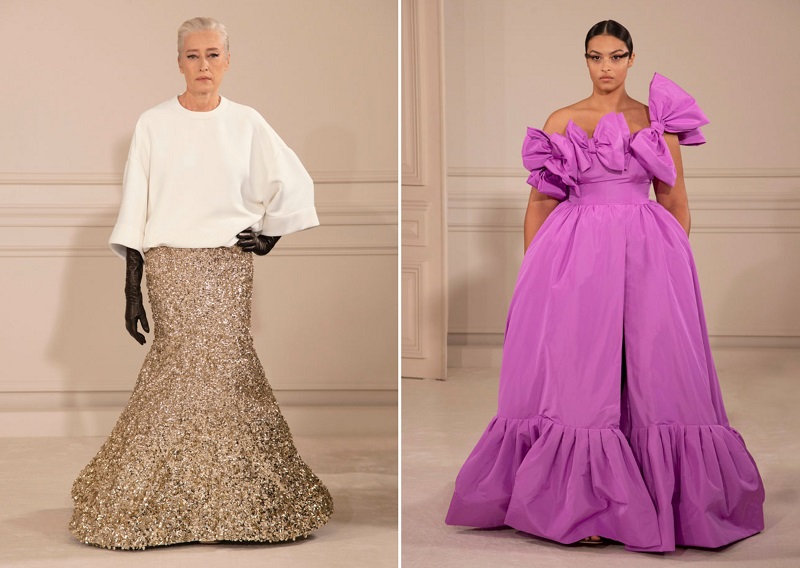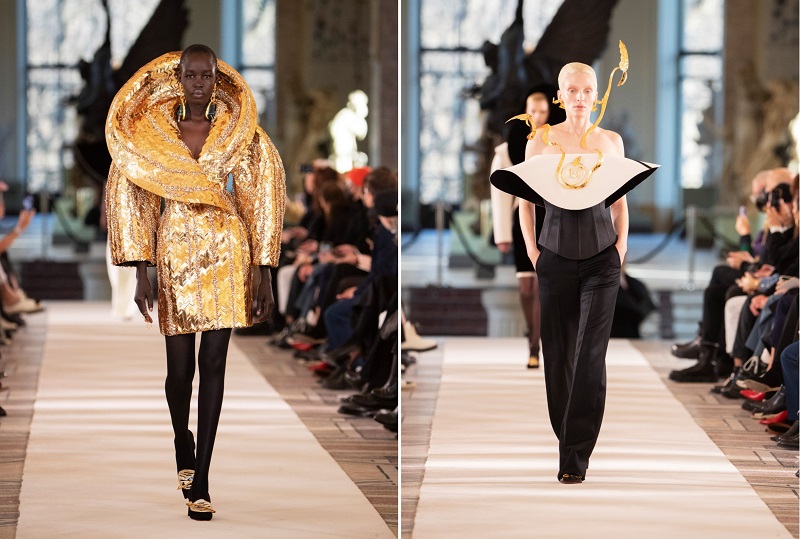
Brands set out to impress at Paris’ haute couture week
In a season that calls for the highest form of craftsmanship in fashion, Paris’ haute couture week is undoubtedly one of the most inspiring events of the year. This season, there was space-age drama at Fendi and Schiaparelli, a princess on a horse on the runway at Chanel and a breakthrough moment with the body-positive outlook at Valentino. Here is our selection of the best shows from Spring/Summer 2022 Haute Couture.
CHANEL
There has been a lot of talk in the fashion world about a return to the “Roaring ’20s” as we move towards a post-pandemic world. After a tumultuous period not so dissimilar to what we are facing now, the 1920s saw an explosion of creative energy and unbridled hedonism. We’ve seen quite a number of nods to this era in recent runway collections as optimistic designers create while imagining better days ahead, and nowhere is that more apparent than in this collection.
The show opened with brand ambassador Charlotte Casiraghi, daughter of Caroline, Princess of Hanover, riding down the runway on a horse wearing a Chanel jacket made of black tweed and sequins, paired with black jodhpurs and tall riding boots. It was one of Paris Couture Week’s most viral moments, and a moment for horse-loving girls everywhere.
02_ss_2022_hc_show_finale_pictures_copyright_chanel_2.jpg

Then followed a series of looks in the house’s signature tweed updated with details that reflected the “ethereal lightness” (as described by the show notes) of the collection, such as feathered sleeves on a dress, trouser legs that split at the side from mid-calf to upper thigh and wrap skirts left purposefully left open at the front to reveal lace or sequins underneath. Soft pinks were offered up next to powdery blues and creamy whites, lending a sense of freshness and femininity to the collection.
The eveningwear was imagined in quintessential silhouettes from the flapper era. Filmy organza and chiffon dresses with drop waists and tiered ruffles in Chanel-esque black and white evoked a Gatsby mood, and staple 1920s elements like ostrich feathers and intricate beading showcased the unparalleled craftsmanship that is key to couture. Creative director Virginie Viard worked with all of Chanel’s specialist embroiderers on the collection. Just to put into context how much work goes into these couture creations, look 19, a black organza skirt with hand-painted pink and mauve camellias and circles of fine silver threaded pearls paired with an hourglass raspberry tweed jacket, took over 1,000 hours to complete.
DIOR
There was a beautiful sense of ease to Maria Grazia Chiuri’s outing for Dior that was anything but simple. The collection rendered immaculately in a limited palette of black, white, grey and beige was a celebration of human connection, a reverential ode to the artisans whose hands painstakingly crafted these creations, and whose work sings in this deliberately pared-back couture offering.
Embroidery was a central focus, masterfully applied not as mere surface decoration, but as an intrinsic part of the construction of the pieces. A long ecru cashmere cape was pieced together with embroidery, not plain stitching, and a silk guipure-like embroidered breastplate was actually part of the construction of a long black silk cady dress, and not a decorative detail, as Chiuri revealed to Vogue.com. When used in an all-over fashion, it transforms into an architectural element, giving garments its shape, as evident in a fully embroidered structured long skirt juxtaposed with a sheer silk organza shirt. Embroidery continued into tights — the signature pieces of the collection — in shimmering splendour as they elevated white and grey skirt suits and completed equally bedazzled leotards. This is a return to the essence of couture: to dress the body and, here, Chuiri sets out to dress every part of it.
Indeed, we are seeing a reassertion of form as the designer explores the interplay between clothing, body and movement, showcased by looks like the pleated skirt that billowed under a structured coat and silver lame dresses that highlighted every movement.
Chuiri set her show against a backdrop of large-scale embroidered tapestries that covered the entirety of the walls, works by Indian artists Madhvi and Manu Parekh that were handcrafted by 380 artisans from Chanakya, the school of crafts in India, and took more than 280,000 hours to embroider, reinforcing the message of craftsmanship and the human touch in art.
VALENTINO
The Valentino collection was a masterclass in refined elegance, with low-slung suiting looks that conveyed effortlessness but were clearly considered, shown alongside grandiose gowns in vibrant hues that we’ve come to expect from Pierpaolo Piccioli. Silk faille, cady and taffeta numbers in fuchsia pink, cornflower blue and Valentino red were completed with dramatic opera coats and gloves as a nod to old couture codes. But there was something else noteworthy happening on the runway besides the (show-stopping) clothes.
Piccioli named the collection “Anatomy of Couture”, as he seeks to boldly redefine it. Fashion’s most exclusive runway is usually reserved for young, white and waif-like models, but Piccioli constructs a message of positivity and inclusivity by sending a diverse range of body types, races and ages down the runway, shattering couture’s most rigid conventions and creating, according to the show notes, “a canon that reflects the richness and diversity of the contemporary world and promoting an idea of beauty that is not absolute”.
schiaparelli_ss22_1.jpg

It is couture norm to fit looks on only one house model, and then applying the body of the house model as a sort of template for the other models on the runway, and while couture has always been made-to-measure, it’s certainly not one size (or style) fits all, as dimensions and silhouettes get distorted during the scaling process. Piccioli got 10 house models in with differently proportioned bodies, and virtuosically created new, beautiful silhouettes. One look in particular was a triumph, a lilac faille gown adorned with maxi bows around the neckline that could easily have been overpowering on a fuller figure, but looked perfectly balanced because of custom proportions and expert placement.
Defying traditional tropes of age-appropriateness, the show opened with 57-year-old supermodel Kristen McMenamy in a mini LBD with a cut-down-to-there moulded neckline, stockings that reached up to just below the ruffled hem and leather gloves. McMenamy, along with other models older than the couture show average, lent an air of confidence that can only come with age to the proceedings, adding a whole different level of appeal. It was also refreshing to see men on a normally female-dominated couture runway. To quote another progressive figure, the times they are a-changing, and Piccioli is proving to be the couturier of the future.
FENDI
Kim Jones brought the drama to couture week in his first haute couture show for Fendi with a live audience. Rome was Jones’ muse this season, as he was inspired by “the eternity of Rome, the spirituality of Rome, the celestial Rome”, as stated in the show notes. Also namechecking Dune and Star Wars as key references, the collection became a love letter to the Eternal City by way of a sort of space odyssey, resulting in a sci-fi romanticism that explored the ancient and the futuristic.
The dark show space, where suspended fragments of Roman arches hung below a planet-like orb, was the perfect cinematic fantasy that haute couture evokes so well. Models stepped through the smoke-filled runway entrance like celestial beings and swept down the runway like the goddesses that they are. Apt, as Jones explained, “that’s what my vision for Fendi is all about, celebrating the power of women”.
It was an evening-centric collection, replete with ethereal gowns in opulent fabrics. Some looks were inspired by archaic Roman clothing such as the peplo and toga, but that wouldn’t seem out of place in an intergalactic world with high-shine crystal beading and embroidery that gave a cosmic quality to the pieces. Others, such as a white mink cape and floor-grazing velvet dresses, were adorned with hand-painted statues that can be found right outside the Fendi Palazzo della Civiltà Italiana headquarters. Spiky black ear cuffs and knuckle-duster rings in crystal geodes and amethyst, designed by Delfina Delettrez, Silvia Venturini Fendi’s daughter, added to the space-age glamour.
Jones looked to the past and the future for inspiration for this collection, drawing upon time-honoured techniques alongside modern craftsmanship, and it all felt so very current.
SCHIAPARELLI
In the refreshingly candid collection notes, Daniel Roseberry asks the existential question of what fashion’s place is in this time of chaos and loss. So fitting coming from the artistic director of a house known for looking at fashion through existentialist and surrealist lens, as he continues, “What does surrealism mean when reality itself has been redefined?” He takes us through his journey of enlightenment while designing this collection, starting by stripping away the usual tropes of couture such as loud colours and poufy silhouettes, looking for a different way to achieve fashion theatre.
Roseberry sought divine inspiration from the heavens and “a mythical high priestess”, but also took cue from space cinema (thanks to a lockdown-induced binge of films such as Dune and Prometheus), merging the heart of Schiaparelli’s surrealist codes with the drama of cosmic costumes. In only a trinity of black, white and gold, a shade exclusively formulated for the house that took multiple seasons to perfect, the designer allowed the focus to be on the extraordinary architecture of the pieces.
The sci-fi silhouettes came in the form of golden Saturn rings orbiting the models’ heads and shoulders and brass tentacles spilling out from a strapless black dress like a deep-sea creature from a James Cameron movie.
schiaparelli_ss22.jpg

The house’s key emblems were also on full tongue-in-cheek display. The iconic palm trees sprouted out of the tailored shoulders of a jacket. A long dress in black georgette was accented with three large discs, one on each wrist and one around the head, embroidered with the Schiaparelli Apollo of Versailles design. And in the most exquisite display of engineering, a gilded cage dress, created using a new technique of hand-moulding wet gold leather, was adorned with familiar motifs — the eyes, the padlock, the lobster, the dove — and encrusted with cabochon stones from the 1930s.
For all its otherworldly elements, it was a collection surprisingly grounded in reality. The elaborate, heavily-detailed gold structures worked because they were embellishing perfectly-cut black trousers, a sharply tailored blazer, or a slinky column dress.
Roseberry ends the show notes by sharing what he has come to discover about fashion throughout this process: “When it’s done right, when it has something to tell us, it can help us feel the inarticulable. It’s because it still has the power to move us.” His collection is a shining example of that, firmly reminding us all that fashion can be a wonderful space of optimism and inspiration in these uncertain times.
This article first appeared on Feb 14, 2022 in The Edge Malaysia.


